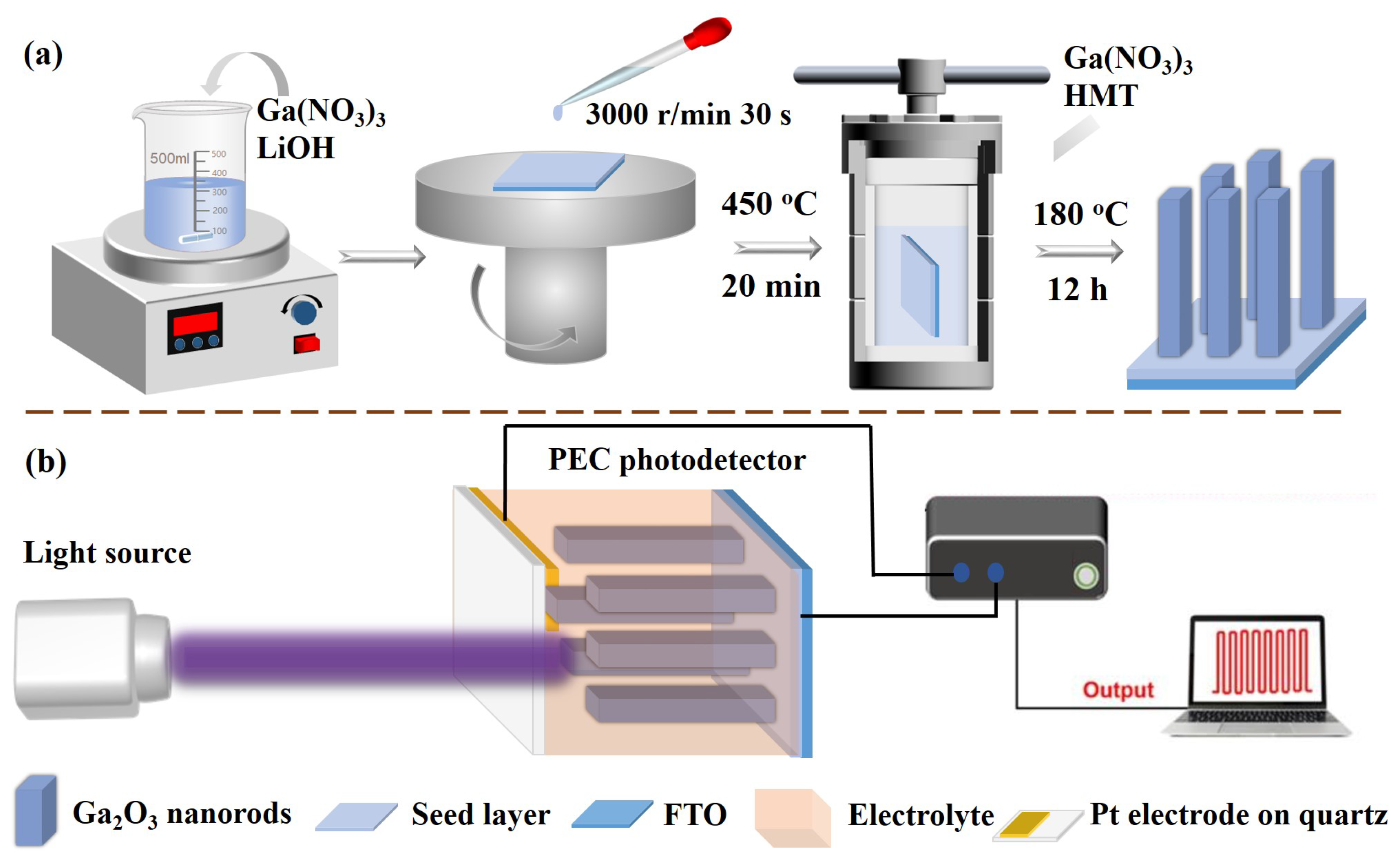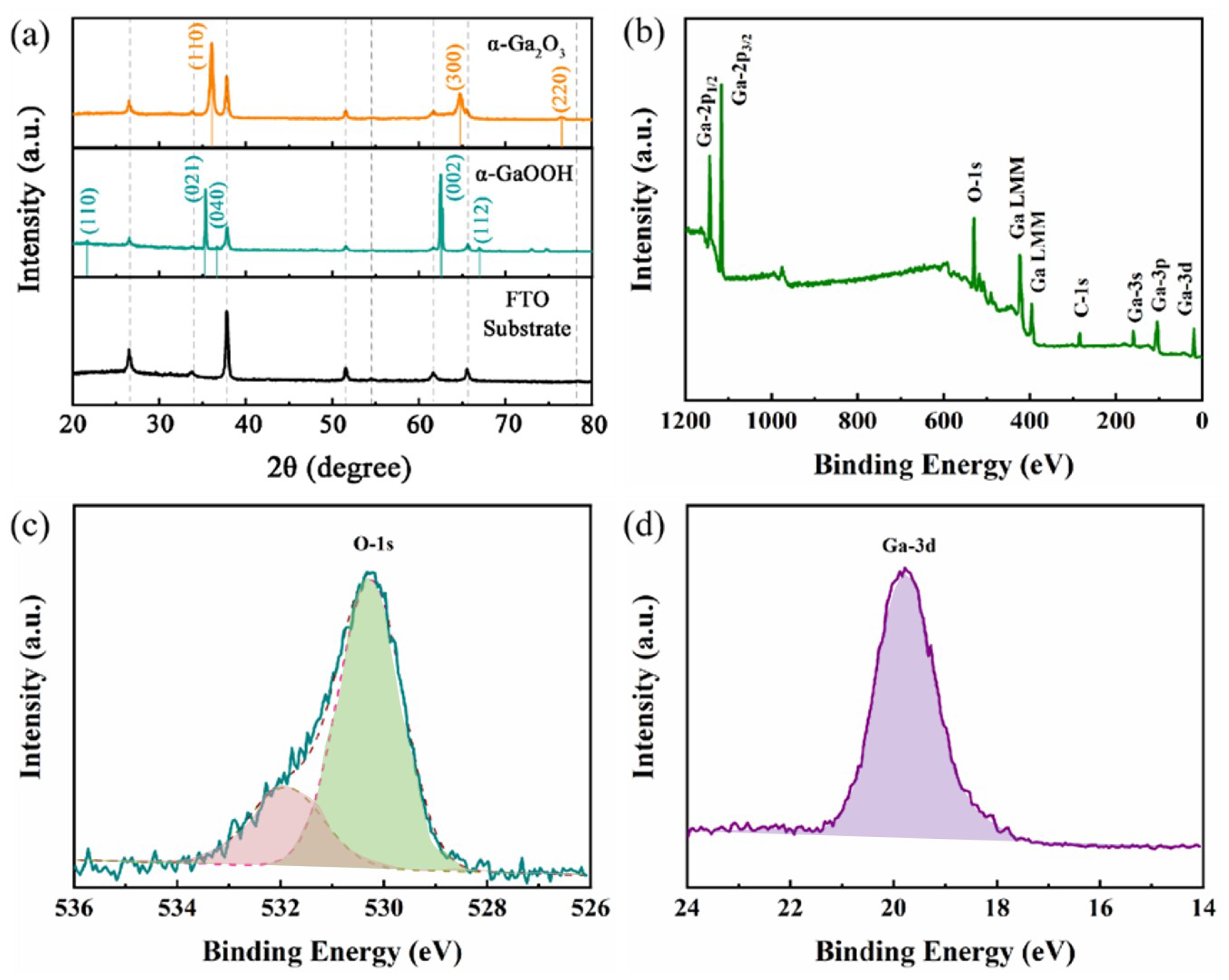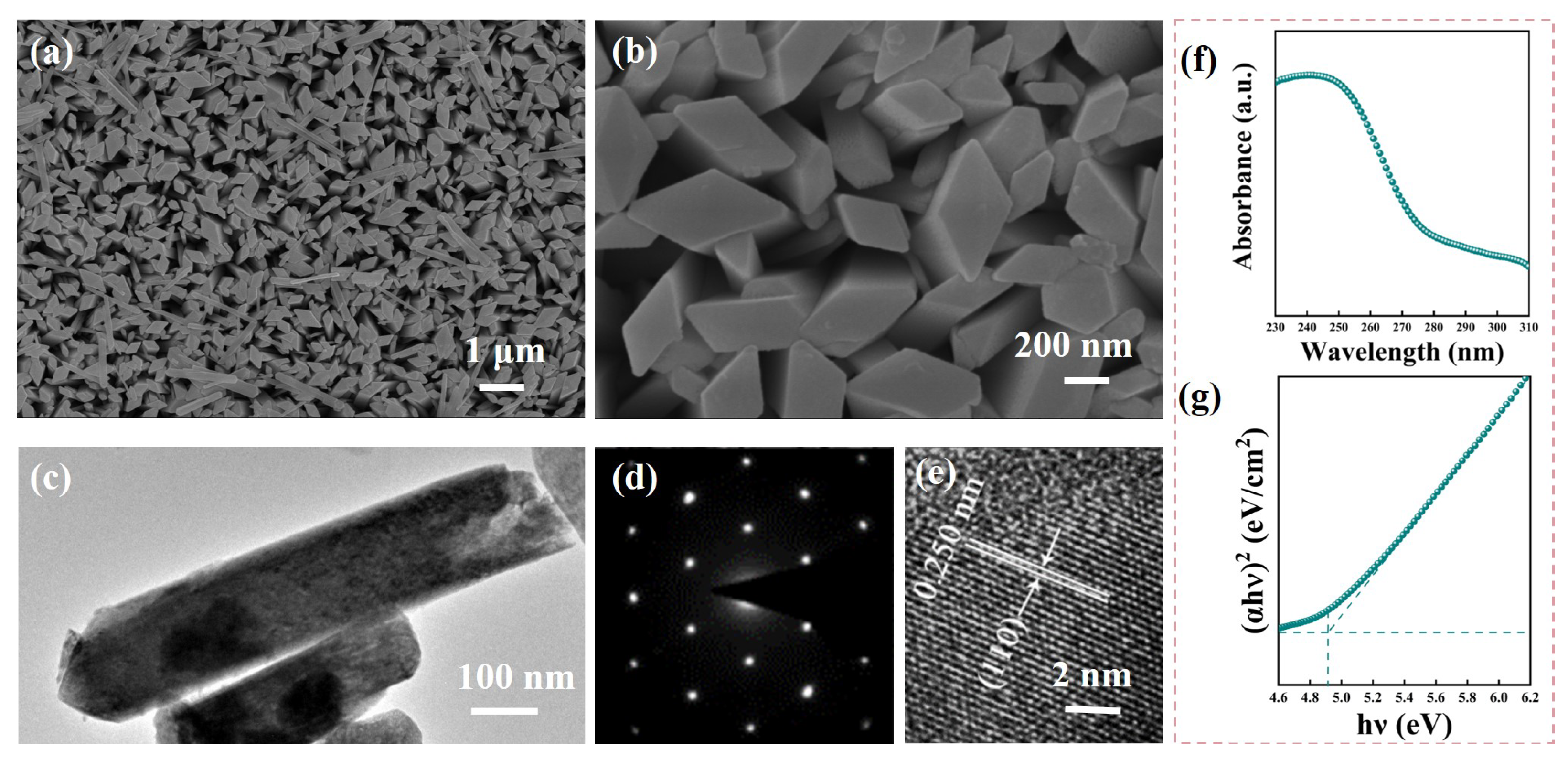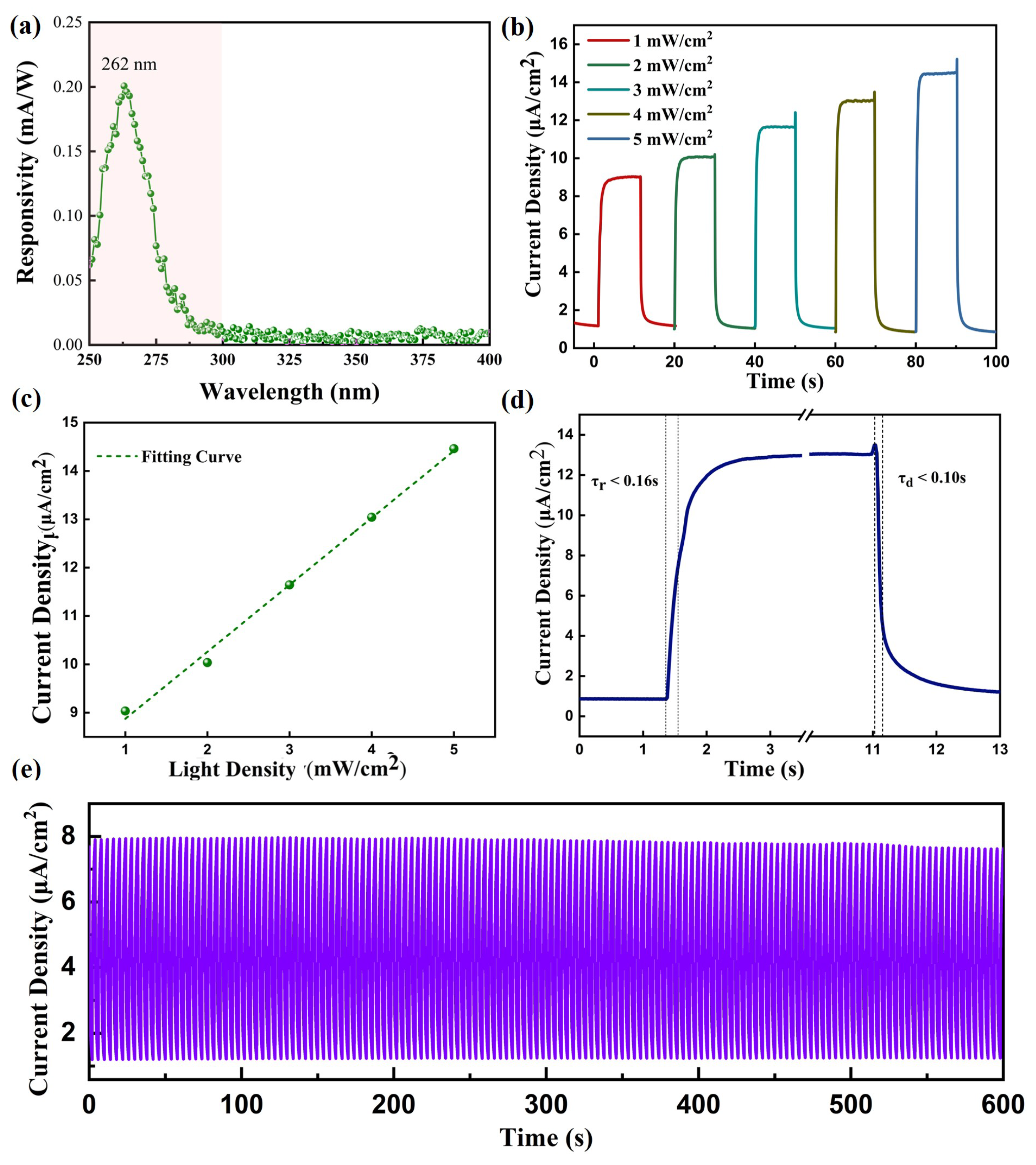The Influence of Electrolytes on the Performance of Self-Powered Photoelectrochemical Photodetector Based on α-Ga2O3 Nanorods
Abstract
:1. Introduction
2. Materials and Methods
3. Results and Discussion
4. Conclusions
Author Contributions
Funding
Institutional Review Board Statement
Informed Consent Statement
Data Availability Statement
Conflicts of Interest
References
- Goswami, L.; Aggarwal, N.; Vashishtha, P.; Jain, S.K.; Nirantar, S.; Ahmed, J.; Khan, M.A.M.; Pandey, R.; Gupta, G. Fabrication of GaN nano-towers based self-powered UV photodetector. Sci. Rep. 2021, 11, 10859. [Google Scholar] [CrossRef] [PubMed]
- Kumar, V.; Maan, A.S.; Akhtar, J. Barrier height inhomogeneities induced anomaly in thermal sensitivity of Ni/4H-SiC Schottky diode temperature sensor. J. Vac. Sci. Technol. B 2014, 32, 041203. [Google Scholar] [CrossRef]
- Kumar, V.; Kaminski, N.; Maan, A.S.; Akhtar, J. Capacitance roll-off and frequency-dispersion capacitance–conductance phenomena in field plate and guard ring edge-terminated Ni/SiO2/4H-n-SiC Schottky barrier diodes. Phys. Status Solidi A 2016, 213, 193–202. [Google Scholar] [CrossRef]
- Nie, Y.; Jiao, S.; Yang, S.; Jing, J.; Zhang, S.; Shi, Z.; Lu, H.; Wang, D.; Gao, S.; Wang, X.; et al. The excellent performance of β-Ga2O3 Schottky photodiode under forward bias and its application in solar-blind ultraviolet communication. Mater. Today Phys. 2023, 33, 101032. [Google Scholar] [CrossRef]
- Zhang, J.; Jiao, S.; Wang, D.; Ni, S.; Gao, S.; Wang, J. Solar-blind ultraviolet photodetection of an α–Ga2O3 nanorod array based on photoelectrochemical self-powered detectors with a simple, newly-designed structure. J. Mater. Chem. C 2019, 7, 6867–6871. [Google Scholar] [CrossRef]
- Oh, S.; Kim, C.K.; Kim, J. High Responsivity β-Ga2O3 Metal-Semiconductor-Metal Solar-Blind Photodetectors with Ultraviolet Transparent Graphene Electrodes. ACS Photonics 2018, 5, 1123–1128. [Google Scholar] [CrossRef]
- Xu, Y.; An, Z.; Zhang, L.; Feng, Q.; Zhang, J.; Zhang, C.; Hao, Y. Solar blind deep ultraviolet β-Ga2O3 photodetectors grown on sapphire by the Mist-CVD method. Opt. Mater. Express 2018, 8, 2941–2947. [Google Scholar] [CrossRef]
- Vigil, E.; Peter, L.M.; Forcade, F.; Jennings, J.R.; Gonzalez, B.; Wang, H.; Curbelo, L.; Dunn, H. An ultraviolet selective photodetector based on a nanocrystalline TiO2 photoelectrochemical cell. Sensors Actuators Phys. 2011, 171, 87–92. [Google Scholar] [CrossRef]
- Zhang, M.; Wang, Y.; Teng, F.; Chen, L.; Li, J.; Zhou, J.; Pan, X.; Xie, E. A photoelectrochemical type self-powered ultraviolet photodetector based on GaN porous films. Mater. Lett. 2016, 162, 117–120. [Google Scholar] [CrossRef]
- Yu, C.; Li, H.; Ding, K.; Huang, L.; Zhang, H.; Pang, D.; Xiong, Y.; Yang, P.A.; Fang, L.; Li, W.; et al. Flexible and Self-Powered Photoelectrochemical-Type Solar-Blind Photodetectors Based on Ag Nanowires-Embedded Amorphous Ga2O3 Films. Adv. Opt. Mater. 2024, 12, 2400116. [Google Scholar] [CrossRef]
- Gazotti, W.; Girotto, E.; Nogueira, A.; De Paoli, M. Solid-state photoelectrochemical cell using a polythiophene derivative as photoactive electrode. Sol. Energy Mater. Sol. Cells 2001, 69, 315–323. [Google Scholar] [CrossRef]
- Ohta, N.; Takada, K.; Sasaki, T.; Watanabe, M. All solid-state photoelectrochemical cell with RbAg4I5 as the electrolyte. Electrochem. Solid State Lett. 2003, 6, A187–A189. [Google Scholar] [CrossRef]
- Marezio, M.; Remeika, J.P. Bond Lengths in the α-Ga2O3 Structure and the High-Pressure Phase of Ga2−xFexO3. J. Chem. Phys. 1967, 46, 1862–1865. [Google Scholar] [CrossRef]
- Battistoni, C.; Dormann, J.; Fiorani, D.; Paparazzo, E.; Viticoli, S. An XPS and Mössbauer study of the electronic properties of ZnCrxGa2−xO4 spinel solid solutions. Solid State Commun. 1981, 39, 581–585. [Google Scholar] [CrossRef]
- Li, Q.; Wei, L.; Xie, Y.; Zhang, K.; Liu, L.; Zhu, D.; Jiao, J.; Chen, Y.; Yan, S.; Liu, G.; et al. ZnO nanoneedle/H2O solid-liquid heterojunction-based self-powered ultraviolet detector. Nanoscale Res. Lett. 2013, 8, 415. [Google Scholar] [CrossRef] [PubMed]
- Ramana, C.V.; Rubio, E.J.; Barraza, C.D.; Miranda Gallardo, A.; McPeak, S.; Kotru, S.; Grant, J.T. Chemical bonding, optical constants, and electrical resistivity of sputter-deposited gallium oxide thin films. J. Appl. Phys. 2014, 115, 043508. [Google Scholar] [CrossRef]
- He, C.; Guo, D.; Chen, K.; Wang, S.; Shen, J.; Zhao, N.; Liu, A.; Zheng, Y.; Li, P.; Wu, Z.; et al. α-Ga2O3 Nanorod Array-Cu2O Microsphere pin Junctions for Self-Powered Spectrum-Distinguishable Photodetectors. ACS Appl. Nano Mater. 2019, 2, 4095–4103. [Google Scholar] [CrossRef]
- Zhou, J.; Chen, L.; Wang, Y.; He, Y.; Pan, X.; Xie, E. An overview on emerging photoelectrochemical self-powered ultraviolet photodetectors. Nanoscale 2016, 8, 50–73. [Google Scholar] [CrossRef] [PubMed]
- Zhang, J.; Jiao, S.; Wang, D.; Gao, S.; Wang, J.; Zhao, L. Nano tree-like branched structure with α-Ga2O3 covered by γ-Al2O3 for highly efficient detection of solar-blind ultraviolet light using self-powered photoelectrochemical method. Appl. Surf. Sci. 2021, 541, 148380. [Google Scholar] [CrossRef]
- Bai, Z.; Zhang, Y. Self-powered UV-visible photodetectors based on ZnO/Cu2O nanowire/electrolyte heterojunctions. J. Alloy. Compd. 2016, 675, 325–330. [Google Scholar] [CrossRef]
- Ni, S.; Guo, F.; Wang, D.; Liu, G.; Xu, Z.; Kong, L.; Wang, J.; Jiao, S.; Zhang, Y.; Yu, Q.; et al. Effect of MgO Surface Modification on the TiO2 Nanowires Electrode for Self-Powered UV Photodetectors. ACS Sustain. Chem. Eng. 2018, 6, 7265–7272. [Google Scholar] [CrossRef]
- Qu, Y.; Wu, Z.; Ai, M.; Guo, D.; An, Y.; Yang, H.; Li, L.; Tang, W. Enhanced Ga2O3/SiC ultraviolet photodetector with graphene top electrodes. J. Alloy. Compd. 2016, 680, 247–251. [Google Scholar] [CrossRef]
- Zhang, Y.; Jiao, S.; Zhang, J.; Liu, S.; Wang, D.; Gao, S.; Wang, J. Study on the evolution from α-GaOOH to α-Ga2O3 and solar-blind detection behavior of an α-GaOOH/α-Ga2O3 heterojunction. Crystengcomm 2022, 24, 1789–1794. [Google Scholar] [CrossRef]
- Zhang, B.; Wu, H.; Feng, C.; Zhang, Z.; Yu, H.; Zhang, C.; Lin, S.; Xu, C.; Bai, H.; Guo, F. Self-Powered Solar-Blind Photodetectors Based on α-Ga2O3 Nanorod Arrays. ACS Appl. Nano Mater. 2022, 5, 11956–11963. [Google Scholar] [CrossRef]
- Huang, L.; Hu, Z.; Zhang, H.; Xiong, Y.; Fan, S.; Kong, C.; Li, W.; Ye, L.; Li, H. A simple, repeatable and highly stable self-powered solar-blind photoelectrochemical-type photodetector using amorphous Ga2O3 films grown on 3D carbon fiber paper. J. Mater. Chem. C 2021, 9, 10354–10360. [Google Scholar] [CrossRef]
- Chen, K.; Wang, S.; He, C.; Zhu, H.; Zhao, H.; Guo, D.; Chen, Z.; Shen, J.; Li, P.; Liu, A.; et al. Photoelectrochemical Self-Powered Solar-Blind Photodetectors Based on Ga2O3 Nanorod Array/Electrolyte Solid/Liquid Heterojunctions with a Large Separation Interface of Photogenerated Carriers. ACS Appl. Nano Mater. 2019, 2, 6169–6177. [Google Scholar] [CrossRef]
- Qu, L.; Ji, J.; Liu, X.; Shao, Z.; Cui, M.; Zhang, Y.; Fu, Z.; Huang, Y.; Yang, G.; Feng, W. Oxygen-vacancy-dependent high-performance α-Ga2O3 nanorods photoelectrochemical deep UV photodetectors. Nanotechnology 2023, 34, 225203. [Google Scholar] [CrossRef]






| Structure of GO3 | Responsivity (mA/W) | Rise/Decay Time (s) | / | Ref. |
|---|---|---|---|---|
| Nanorod array | 0.212 | 0.076, 0.056 | 33.74 | Ref. [5] |
| Nanorod array | 3.87 | 0.23, 0.15 | 12.81 | Ref. [24] |
| Amorphous films on 3D CFP | 12.90 | 0.15, 0.13 | - | Ref. [25] |
| Nanorod array | - | <0.5, <0.2 | 28.97 | Ref. [26] |
| Nanorod array | 101.5 | 1, 3.2 | - | Ref. [27] |
| Nanorod array | 0.2 | 0.16, 0.10 | 35 | This work |
Disclaimer/Publisher’s Note: The statements, opinions and data contained in all publications are solely those of the individual author(s) and contributor(s) and not of MDPI and/or the editor(s). MDPI and/or the editor(s) disclaim responsibility for any injury to people or property resulting from any ideas, methods, instructions or products referred to in the content. |
© 2024 by the authors. Licensee MDPI, Basel, Switzerland. This article is an open access article distributed under the terms and conditions of the Creative Commons Attribution (CC BY) license (https://creativecommons.org/licenses/by/4.0/).
Share and Cite
He, J.; Tao, C.; Zhang, Y.; Sun, J.; Zhang, X.; Jiao, S.; Wang, D.; Wang, J. The Influence of Electrolytes on the Performance of Self-Powered Photoelectrochemical Photodetector Based on α-Ga2O3 Nanorods. Materials 2024, 17, 3665. https://doi.org/10.3390/ma17153665
He J, Tao C, Zhang Y, Sun J, Zhang X, Jiao S, Wang D, Wang J. The Influence of Electrolytes on the Performance of Self-Powered Photoelectrochemical Photodetector Based on α-Ga2O3 Nanorods. Materials. 2024; 17(15):3665. https://doi.org/10.3390/ma17153665
Chicago/Turabian StyleHe, Junjie, Chenyang Tao, Yanan Zhang, Jiufu Sun, Xiangyun Zhang, Shujie Jiao, Dongbo Wang, and Jinzhong Wang. 2024. "The Influence of Electrolytes on the Performance of Self-Powered Photoelectrochemical Photodetector Based on α-Ga2O3 Nanorods" Materials 17, no. 15: 3665. https://doi.org/10.3390/ma17153665






